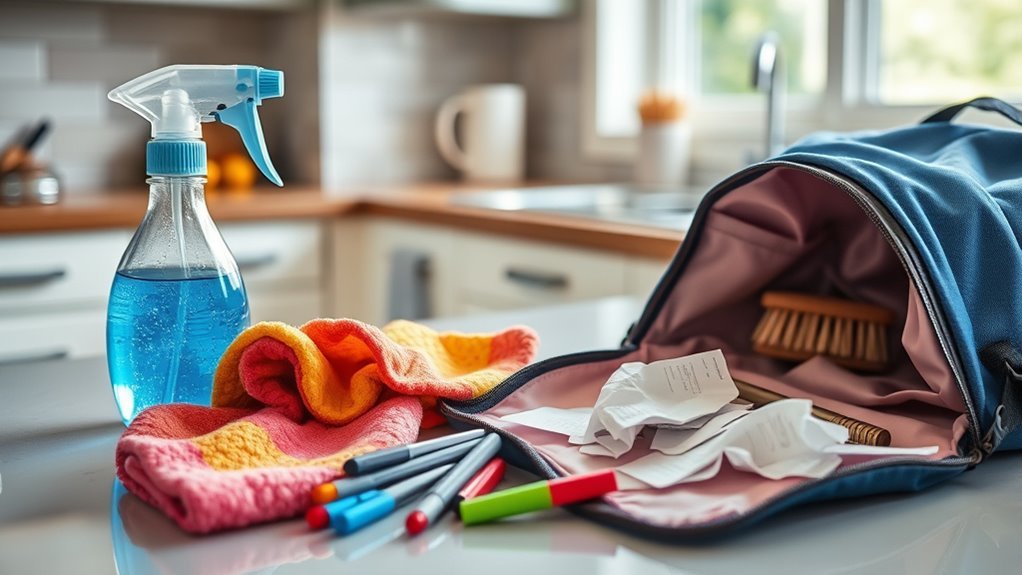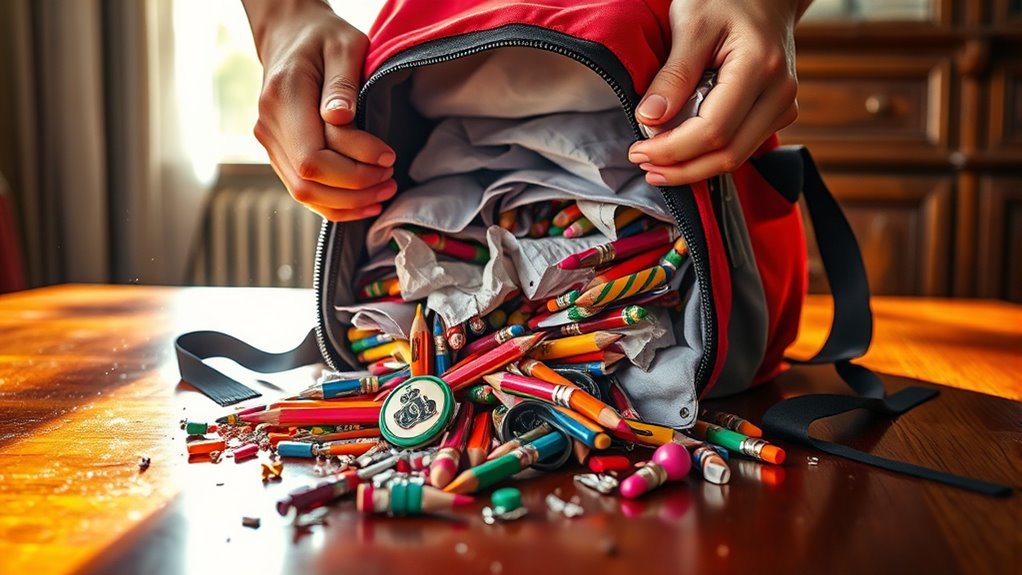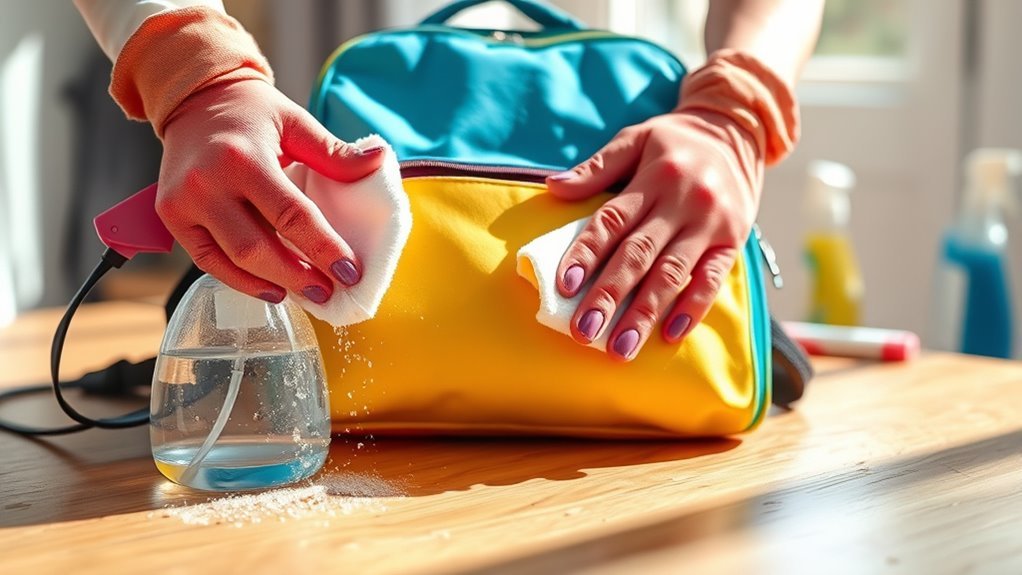Weekly Cleaning Routine for School Bag
To keep your school bag fresh and organized weekly, start by emptying all contents and shaking out debris. Use a handheld vacuum to clean inside pockets and exterior fabric gently. Spot clean stains with mild, tested cleaners and wipe zippers and hardware. Let your bag air dry fully in a shaded, airy spot, then reorganize essentials neatly before storing it off the floor in a cool, dry place. Follow these steps consistently for best results, and you’ll uncover additional tips to maintain your bag’s longevity.
Gather Cleaning Supplies

To start your weekly cleaning routine, gather all the necessary supplies before you begin. You’ll need versatile cleaning products like mild detergent, disinfectant wipes, a soft brush, and microfiber cloths to tackle different surfaces efficiently. Prepare a small container or caddy to keep everything organized and within reach. Organization tips include grouping supplies by function—cleaning, scrubbing, drying—to avoid wasting time searching. Having a checklist on hand guarantees you don’t forget essentials. Avoid harsh chemicals that could damage your bag’s material or irritate your skin. By assembling the right tools ahead of time, you set yourself up for a smooth, focused cleaning session. This simple preparation frees up your time and energy, so you can maintain a neat, functional school bag without hassle.
Empty All Contents From the Bag
Before you start cleaning, empty every item from your school bag. This step is essential for effective bag organization and a thorough content assessment. Lay out everything on a flat surface, so you can clearly see what you have. This helps you decide what to keep, toss, or relocate.
| Item Category | Condition Check | Action Needed |
|---|---|---|
| Books & Notebooks | Good / Worn Out | Keep / Replace |
| Stationery | Usable / Broken | Keep / Discard |
| Miscellaneous | Needed / Unnecessary | Keep / Remove |
Emptying your bag fully gives you control and freedom to reorganize efficiently. It’s the foundation for a clean, functional school bag every week.
Shake Out Loose Debris

Once you’ve emptied your bag, give it a good shake to remove any loose dirt, crumbs, or debris hiding inside. This simple step is essential in bag maintenance, preventing buildup that can cause wear or odors. Hold your bag firmly and shake it over a trash bin or outdoors, allowing gravity to do the work. For stubborn debris stuck in corners or seams, turn the bag inside out if possible, and tap gently. This systematic debris management keeps your bag fresh and ready for the week ahead. Regularly shaking out your bag reduces the need for intensive cleaning later, saving time and effort. Incorporate this easy habit into your weekly routine to maintain a clean, functional bag that supports your freedom to move without clutter.
Spot Clean Stains and Marks
When you spot stains or marks on your school bag, first identify the type of stain to pick the right cleaning solution. Use gentle tools like soft cloths or brushes to avoid damaging the fabric. This targeted approach helps remove stains effectively without harming your bag.
Identify Stain Types
Although it may seem tedious, identifying the type of stain on your school bag is essential for effective spot cleaning. Using proper stain identification techniques helps you tackle marks without damaging your bag’s fabric. Here are four common stain types to recognize:
- Oil-based stains – From snacks or lotion, usually dark and greasy.
- Water-based stains – Caused by drinks or mud, often light and easy to spot.
- Ink stains – Typically sharp, dark spots from pens or markers.
- Organic stains – Food or dirt that may have a distinct smell or discoloration.
Pinpointing the stain type lets you apply the right cleaning method, saving you time and preserving your bag’s look. Don’t skip this step if you want freedom from stubborn marks!
Choose Cleaning Solutions
Knowing the type of stain on your school bag helps you pick the right cleaning solution to tackle it effectively. Start by selecting eco friendly cleaners that won’t harm the environment or your bag. For fabric stains, opt for fabric safe solutions designed specifically to preserve material integrity. Avoid harsh chemicals, as they can weaken fibers and fade colors. Use a small amount of cleaner on a hidden spot first to test for any adverse reactions. Target oil-based stains with mild detergents, while water-based marks respond well to vinegar and water mixtures. Always apply the solution gently and let it sit briefly before wiping. This approach keeps your bag fresh without compromising its durability, giving you the freedom to carry it confidently every day.
Use Gentle Cleaning Tools
Two gentle cleaning tools you’ll want on hand are soft cloths and soft-bristled brushes. These help you spot clean stains and marks without damaging your school bag’s fabric. Here’s how to use them effectively:
- Dampen a soft cloth with mild cleaning solution for delicate wiping.
- Use gentle brushes to loosen dirt from seams and textured areas.
- Blot stains instead of rubbing to prevent spreading or fabric wear.
- Rinse cloths frequently to avoid reapplying dirt onto the bag.
Vacuum the Interior and Exterior
You’ll want to vacuum both the inside and outside of your school bag to remove dust and crumbs effectively. Use a brush attachment to reach into corners and loosen dirt around zippers. Taking care with zippers guarantees they stay functional and free from debris buildup.
Effective Dust Removal
Although it might seem simple, vacuuming both the interior and exterior of your school bag is essential for removing dust and debris that accumulate daily. This practice supports effective dusting techniques and plays a key role in allergy prevention. Here’s how to do it right:
- Use a handheld vacuum with a brush attachment to reach tight corners inside the bag.
- Vacuum the exterior fabric gently to avoid damage while lifting surface dust.
- Empty all compartments before vacuuming to expose hidden dust buildup.
- Perform this routine weekly to maintain cleanliness and reduce allergens effectively.
Cleaning Tips for Zippers
Vacuuming the interior and exterior of your school bag helps clear out dust, but the zippers often need extra attention to stay functional. For effective zipper maintenance, start by gently vacuuming along the zipper teeth to remove trapped debris. Next, inspect the zipper for any stubborn dirt or sticky residue and clean it carefully with a soft brush or cloth. Once clean, apply lubrication techniques using a small amount of zipper lubricant or a graphite pencil along the teeth to guarantee smooth movement. Avoid using oils that attract dirt. Regularly performing these steps prevents zipper jams and extends their lifespan, giving you the freedom to rely on your bag without hassle. Incorporate this into your weekly routine for hassle-free zipper function every day.
Hand Wash or Wipe Down the Fabric

Since your school bag faces daily dirt and spills, hand washing or wiping down the fabric is essential to keep it clean and fresh. Proper fabric care helps maintain the bag’s look and longevity without restricting your busy lifestyle.
Follow these steps for effective hand washing and wiping:
- Use a mild detergent mixed with lukewarm water to avoid damaging the fabric.
- Dip a soft cloth or sponge into the solution and gently scrub the fabric surface.
- For tough stains, let the detergent sit for 10 minutes before wiping.
- Rinse with a clean damp cloth to remove soap residue, then air dry completely.
Clean Zippers and Hardware
One key step to maintaining your school bag is cleaning the zippers and hardware regularly. Start by brushing away dirt and debris from zipper teeth using a soft brush or an old toothbrush. This prevents jams and guarantees smooth zipper movement. For stubborn grime, dampen a cloth with mild soap and gently wipe the hardware, including buckles and clasps. Avoid soaking metal parts to prevent rust. After cleaning, apply a small amount of zipper lubricant or a silicone-based spray to keep the zipper running smoothly—this is essential zipper maintenance. Regular hardware care not only extends the life of your bag but also keeps it functional and hassle-free. By staying consistent, you free yourself from annoying snags and broken pieces that can slow you down.
Dry the Bag Thoroughly
After cleaning your school bag, you’ll need to dry it thoroughly to prevent mold and odors. Effective drying techniques are key to moisture prevention and keeping your bag fresh. Follow these steps:
- Open all compartments and pockets to maximize airflow.
- Use a clean towel to pat down interior and exterior surfaces, removing excess water.
- Hang your bag upside down in a well-ventilated area, avoiding direct sunlight to preserve materials.
- Allow it to air dry completely, which may take several hours depending on fabric thickness.
Avoid using heat sources like hair dryers, as they can damage the bag’s fabric. By mastering these drying techniques, you’ll maintain your bag’s condition and enjoy the freedom of a clean, odor-free school bag every week.
Organize and Replace Items
Start by sorting through every pocket and compartment, removing any items that don’t belong or are no longer needed. This clears space and makes it easier to organize supplies efficiently. Next, group similar items together—pens with pens, notebooks with notebooks—to maintain order and quick access. Check each essential supply: if any are worn out, broken, or missing, replace items promptly to avoid last-minute scrambles. Prioritize functionality and simplicity, keeping only what’s necessary for your current needs. A well-organized bag reduces stress and saves time, giving you the freedom to focus on what matters. By regularly organizing supplies and replacing items, you maintain a streamlined system that supports your daily routine without clutter or confusion.
Store the Bag Properly Between Uses
Properly storing your school bag between uses can extend its lifespan and keep it ready for the week ahead. To maintain your bag’s condition, focus on bag storage with proper placement that prevents damage and clutter. Here’s how to do it efficiently:
- Choose a dry, cool spot away from direct sunlight to avoid fading and material breakdown.
- Hang your bag on a sturdy hook or a dedicated rack to preserve its shape and prevent creases.
- Keep the bag off the floor to protect it from dirt, moisture, and pests.
- Store it slightly open or with airflow to prevent odors and mildew buildup.
Frequently Asked Questions
How Often Should I Replace My School Bag?
You should replace your school bag when you notice clear signs of replacement like broken zippers, torn fabric, or uncomfortable straps. Typically, the ideal lifespan of a school bag is about 1 to 2 years, depending on usage and quality. Don’t wait until it’s completely unusable; swapping it out on time keeps your load manageable and supports your freedom to move without hassle or extra weight.
What Materials Are Best for Durable School Bags?
Looking for a school bag that stands the test of time? Think of it as choosing your daily armor. Canvas options offer a classic look with breathability and moderate durability, perfect for freedom lovers who want style and function. Meanwhile, nylon durability is unmatched—it’s lightweight, water-resistant, and tough against wear and tear. For practical, long-lasting use, combining these materials or opting for high-quality nylon will keep your bag reliable through every adventure.
Can I Use a Washing Machine for My School Bag?
You can use a washing machine for your school bag, but you’ve got to be careful with machine settings to avoid damage. Choose a gentle cycle with cold water and remove any detachable parts first. Place the bag in a pillowcase or laundry bag to protect it. Always check the bag care label for specific instructions. This way, you maintain durability while keeping your bag fresh and ready for your next adventure.
How Do I Prevent Bad Odors in My Bag?
To prevent bad odors in your bag, use odor absorbing products like activated charcoal bags or baking soda sachets inside. Regularly empty and air out your bag using air freshening techniques—leave it open in a well-ventilated spot or near a fan. Avoid damp items inside to reduce moisture buildup, which causes smells. These simple steps keep your bag fresh, letting you carry your freedom without the stink.
Are Antibacterial Sprays Safe for School Bags?
You might worry antibacterial sprays could damage your bag’s fabric or leave harsh residues. But with proper use, antibacterial effectiveness and spray safety go hand in hand. Choose sprays labeled safe for fabrics, test on a small spot first, and avoid oversaturating. This way, you keep germs at bay without sacrificing your bag’s look or your freedom to carry it confidently every day.






